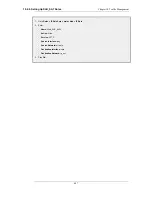
10.2. IDP Traffic Shaping
10.2.1. Overview
The IDP Traffic Shaping feature is traffic shaping that is performed based on information coming
from the NetDefendOS Intrusion Detection and Prevention (IDP) subsystem (for more information
on IDP see Section 6.5, “Intrusion Detection and Prevention”).
Application Related Bandwidth Usage
A typical problem that can be solved with IDP Traffic Shaping is dealing with the traffic
management issues caused by bandwidth hungry applications. A typical example of this is traffic
related to peer-to-peer (P2P) data transfer applications which include such things as Bit Torrent and
Direct Connect.
The high traffic loads created by P2P transfers can often have a negative impact on the quality of
service for other network users as bandwidth is quickly absorbed by such applications. An ISP or a
corporate network administrator may therefore need to identify and control the bandwidth consumed
by these applications and IDP Traffic Shaping can provide this ability.
Combining IDP and Traffic Shaping
One of the issues with controlling a traffic type such as P2P is to be able to distinguish it from other
traffic. The signature database of NetDefendOS IDP already provides a highly effective means to
perform this recognition and as an extension to this, NetDefendOS also provides the ability to apply
throttling through the NetDefendOS traffic shaping subsystem when the targeted traffic is
recognized.
IDP Traffic Shaping is a combination of these two features, where traffic flows identified by the
IDP subsystem automatically trigger the setting up of traffic shaping pipes to control those flows.
10.2.2. Setting Up IDP Traffic Shaping
The steps for IDP Traffic Shaping setup are as follows:
1.
Define an IDP rule that triggers on targeted traffic.
The IDP signature chosen determines which traffic is to be targeted and the signature usually
has the word "POLICY" in its name which indicates it relates to specific applications types.
2.
Select the rule's action to be the Pipe option.
This specifies that IDP Traffic Shaping is to be performed on the connection that triggers the
rule and on subsequent, related connections.
3.
Select a Bandwidth value for the rule.
This is the total bandwidth that will be allowed for the targeted traffic. The traffic measured is
the combination of the flow over the triggering connection plus the flow from any associated
connections, regardless of flow direction.
Connections opened before IDP triggered will not be subject to any restriction.
4.
Optionally enter a Time Window in seconds.
This will be the period of time after rule triggering during which traffic shaping is applied to
any associated connections that are opened.
Typically, a P2P transfer starts with an initial connection to allow transfer of control
10.2. IDP Traffic Shaping
Chapter 10. Traffic Management
472
Summary of Contents for DFL-1600 - Security Appliance
Page 27: ...1 3 NetDefendOS State Engine Packet Flow Chapter 1 NetDefendOS Overview 27 ...
Page 79: ...2 7 3 Restore to Factory Defaults Chapter 2 Management and Maintenance 79 ...
Page 146: ...3 9 DNS Chapter 3 Fundamentals 146 ...
Page 227: ...4 7 5 Advanced Settings for Transparent Mode Chapter 4 Routing 227 ...
Page 241: ...5 4 IP Pools Chapter 5 DHCP Services 241 ...
Page 339: ...6 7 Blacklisting Hosts and Networks Chapter 6 Security Mechanisms 339 ...
Page 360: ...7 4 7 SAT and FwdFast Rules Chapter 7 Address Translation 360 ...
Page 382: ...8 3 Customizing HTML Pages Chapter 8 User Authentication 382 ...
Page 386: ... The TLS ALG 9 1 5 The TLS Alternative for VPN Chapter 9 VPN 386 ...
Page 439: ...Figure 9 3 PPTP Client Usage 9 5 4 PPTP L2TP Clients Chapter 9 VPN 439 ...
Page 450: ...9 7 6 Specific Symptoms Chapter 9 VPN 450 ...
Page 488: ...10 4 6 Setting Up SLB_SAT Rules Chapter 10 Traffic Management 488 ...
Page 503: ...11 6 HA Advanced Settings Chapter 11 High Availability 503 ...
Page 510: ...12 3 5 Limitations Chapter 12 ZoneDefense 510 ...
Page 533: ...13 9 Miscellaneous Settings Chapter 13 Advanced Settings 533 ...














































